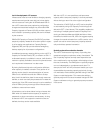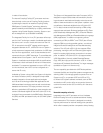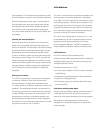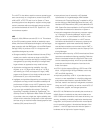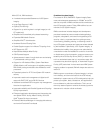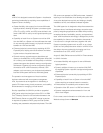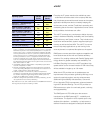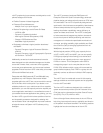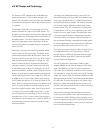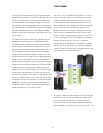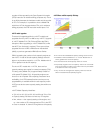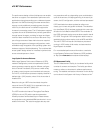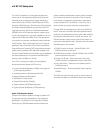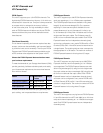of your business. With the potential for increased perfor-
mance and capacity, you have an opportunity to continue
to consolidate diverse applications on a single platform.
The z10 EC is designed to provide up 1.7 times the total
system capacity than the z9 EC, and has up to triple the
available memory. The maximum number of Processor
Units (PUs) has grown from 54 to 64, and memory has
increased from 128 GB per book and 512 GB per system
to 384 GB per book and 1.5 TB per system.
The z10 EC will continue to use the Cargo cage for its I/O,
supporting up to 960 Channels on the Model E12 (64 I/O
features) and up to 1,024 (84 I/O features) on the Models
E26, E40, E56 and E64.
HiperDispatch helps provide increased scalability and per-
formance of higher n-way and multi-book z10 EC systems
by improving the way workload is dispatched across the
server. HiperDispatch accomplishes this by recognizing
the physical processor where the work was started and
then dispatching subsequent work to the same physical
processor. This intelligent dispatching helps reduce the
movement of cache and data and is designed to improve
CPU time and performance. HiperDispatch is available
only with new z10 EC PR/SM and z/OS functions.
Processor Units (cores) defi ned as Internal Coupling
Facilities (ICFs), Integrated Facility for Linux (IFLs), System
z10 Application Assist Processor (zAAPs) and System
z10 Integrated Information Processor (zIIPs) are no longer
grouped together in one pool as on the z990, but are
grouped together in their own pool, where they can be
managed separately. The separation signifi cantly simpli-
fi es capacity planning and management for LPAR and can
have an effect on weight management since CP weights
and zAAP and zIIP weights can now be managed sepa-
rately. Capacity BackUp (CBU) features are available for
IFLs, ICFs, zAAPs and zIIPs.
For LAN connectivity, z10 EC provides a OSA-Express3
2-port 10 Gigabit Ethernet (GbE) Long Reach feature along
with the OSA-Express3 Gigabit Ethernet SX and LX with
four ports per features. The z10 EC continues to support
OSA-Express2 1000BASE-T and GbE Ethernet features,
and supports IP version 6 (IPv6) on HiperSockets. OSA-
Express2 OSN (OSA for NCP) is also available on System
z10 EC to support the Channel Data Link Control (CDLC)
protocol, providing direct access from the host operating
system images to the Communication Controller for Linux
on the z10 EC, z10 BC, z9 EC and z9 (CCL) using OSA-
Express3 or OSA-Express2 to help eliminate the require-
ment for external hardware for communications.
Additional channel and networking improvements include
support for Layer 2 and Layer 3 traffi c, FCP management
facility for z/VM and Linux for System z, FCP security
improvements, and Linux support for HiperSockets IPv6.
STP enhancements include the additional support for NTP
clients and STP over Infi niBand links.
Like the System z9 EC, the z10 EC offers a confi gurable
Crypto Express2 feature, with PCI-X adapters that can
be individually confi gured as a secure coprocessor or
an accelerator for SSL, the TKE workstation with optional
Smart Card Reader, and provides the following CP Assist
for Cryptographic Function (CPACF):
• DES, TDES, AES-128, AES-192, AES-256
• SHA-1, SHA-224, SHA-256, SHA-384, SHA-512
• Pseudo Random Number Generation (PRNG)
z10 EC is designed to deliver the industry leading Reli-
ability, Availability and Serviceability (RAS) custom-
ers expect from System z servers. RAS is designed to
reduce all sources of outages by reducing unscheduled,
scheduled and planned outages. Planned outages are
further designed to be reduced by reducing preplanning
requirements.
12



